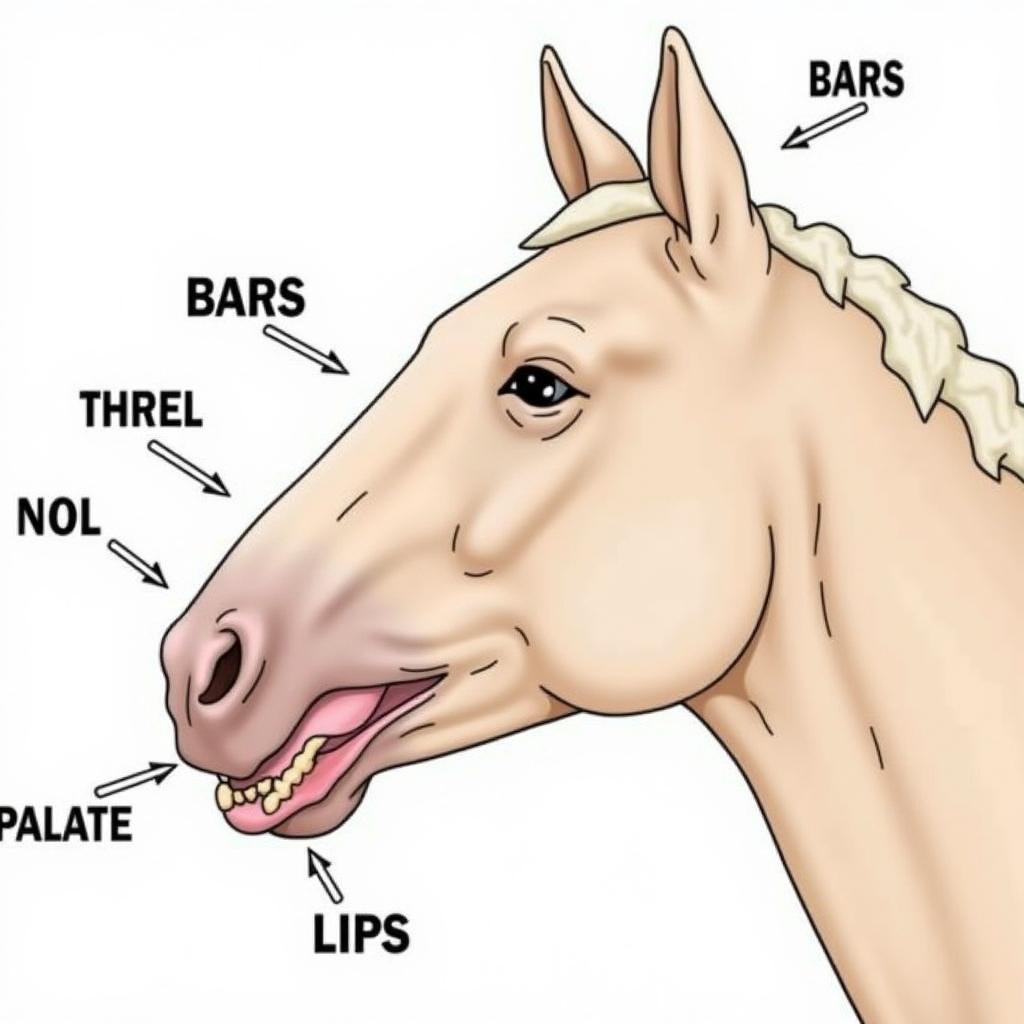Horse Bit Mouthpieces are an essential part of a horse’s bridle, acting as a communication tool between horse and rider. Choosing the correct bit is crucial for your horse’s comfort and performance. With countless variations in design and materials, understanding the nuances of horse bit mouthpieces can seem daunting. This comprehensive guide will equip you with the knowledge to make informed decisions for your equine partner.
Factors to Consider When Choosing Horse Bit Mouthpieces
Selecting the right horse bit mouthpiece isn’t a one-size-fits-all approach. Several factors come into play, each influencing your horse’s comfort and your riding experience.
Horse’s Mouth Conformation
Every horse is unique, and their mouth conformation is no exception. Consider the following:
- Mouth Size and Shape: Bits come in various widths to accommodate different mouth sizes. A bit that’s too narrow will pinch, while one that’s too wide might slide excessively.
- Tongue Width and Sensitivity: Some horses have fleshy tongues, while others are more sensitive. The bit’s mouthpiece design should provide adequate tongue relief without excessive pressure.
- Bars: The bars are the sensitive area in the horse’s mouth where the bit rests. Look for bits that distribute pressure evenly and avoid putting excessive pressure on this area.
 Horse Mouth Anatomy
Horse Mouth Anatomy
Horse’s Age and Training Level
A horse’s age and training level play a significant role in bit selection.
- Young or Green Horses: Generally require milder bits with less leverage. Snaffle bits are a popular choice for starting horses due to their direct action.
- Experienced Horses: Can handle more complex bits with varying levels of leverage and tongue pressure, depending on their training and discipline.
 Horse and Rider Training
Horse and Rider Training
Riding Discipline and Purpose
The type of riding you do will dictate the most appropriate bit:
- English Riding: Often utilizes snaffle bits for disciplines like dressage and hunter/jumper, while pelham bits or double bridles are common in higher levels of dressage.
- Western Riding: May employ curb bits with shanks for leverage in disciplines like reining, cutting, and barrel racing.
- Trail Riding: Often favors milder bits that offer comfort for long rides, such as snaffles or mhackamore bits.
 Western Riding Competition
Western Riding Competition
Types of Horse Bit Mouthpieces
Horse bit mouthpieces can be broadly categorized based on their design and action:
Snaffle Bits
Snaffle bits are considered the mildest type of bit. They have a direct action, meaning pressure applied to the reins directly translates to pressure on the horse’s mouth.
- Types of Snaffle Mouthpieces: Include eggbutt, loose ring, D-ring, and full cheek snaffles. Each variation offers a slightly different feel and level of control.
- Suitable For: Starting horses, English riding disciplines, and horses needing a milder bit.
Check out our selection of snaffle horse bits.
Curb Bits
Curb bits operate with leverage, applying pressure to the poll, chin, and bars of the mouth. The severity of the curb bit depends on the length of the shank.
- Types of Curb Mouthpieces: Include a wide variety of mouthpieces, such as ported, solid, and twisted wire, each offering a different pressure point and feel.
- Suitable For: Western riding disciplines, experienced horses, and situations requiring more control.
Learn more about chain shank horse bits.
Other Bit Types
Beyond snaffles and curbs, there are numerous specialized bit mouthpieces:
- Pelham Bits: Combine elements of both snaffle and curb action, offering versatility in pressure points.
- Double Bridles: Utilize two bits simultaneously – a bradoon (snaffle) and a curb – for refined communication in high-level dressage.
- Hackamore Bits: Don’t have a mouthpiece at all. Instead, they use nose pressure for control, making them a suitable option for horses with mouth sensitivities.
Materials and Construction
Horse bit mouthpieces are crafted from various materials, each impacting the bit’s action and the horse’s acceptance:
- Stainless Steel: Durable, rust-resistant, and generally well-tolerated by most horses.
- Sweet Iron: Oxidizes (rusts) slightly, creating a sweet taste that encourages salivation and acceptance of the bit.
- Copper: Similar to sweet iron, copper promotes salivation. Some bits feature copper inlays for added taste and to encourage a softer mouth.
- Synthetic Materials: Like rubber or plastic, can be gentler on the mouth, making them suitable for young or sensitive horses.
Fitting and Adjusting the Bit
Proper bit fit is essential for horse comfort and performance. A poorly fitting bit can cause discomfort, pain, and even behavioral issues.
- Signs of a Poorly Fitting Bit: Excessive head tossing, gaping, tongue lolling, and resistance to the bit are all signs that the bit may not fit properly.
- Professional Bit Fitting: Consulting with a qualified equine dentist or bitting specialist is highly recommended for ensuring a correct and comfortable fit.
Caring for Your Horse’s Bit
Regular bit care is crucial for hygiene and longevity:
- Daily Cleaning: Rinse the bit after each use to remove saliva and debris.
- Periodic Deep Cleaning: Use a mild detergent and a bit brush to remove any built-up grime.
- Storage: Store bits in a clean, dry place to prevent rust and damage.
Conclusion
Choosing the right horse bit mouthpiece is a multifaceted decision that requires careful consideration of your horse’s individual needs and your riding goals. By understanding the various types, materials, and fitting considerations, you can ensure a comfortable and effective communication channel between you and your equine partner. Remember, when it comes to horse bits, one size does not fit all. Always prioritize your horse’s well-being and seek professional guidance if you have any doubts or concerns.
Need help finding the perfect bit for your horse? Browse our wide selection of horse tack store or contact our knowledgeable team for expert advice.
FAQs About Horse Bit Mouthpieces
1. How often should I change my horse’s bit?
There’s no set timeframe for replacing a bit. However, it’s crucial to regularly inspect it for wear and tear, replacing it immediately if you notice any cracks, chips, or sharp edges.
2. My horse seems uncomfortable in his current bit. What should I do?
Discomfort with a bit can manifest in various ways, such as head tossing, tongue lolling, or resistance. If you notice these signs, it’s essential to consult with a qualified equine professional to assess the fit of your horse’s bit and explore alternative options.
3. Can I use the same bit for all riding disciplines?
While some bits might be versatile enough for multiple disciplines, it’s generally recommended to choose a bit specifically suited for the demands of each riding style. Different disciplines require varying levels of control and leverage, and a bit that’s appropriate for one might not be ideal for another.
4. What is the difference between a snaffle bit and a curb bit?
Snaffle bits operate with direct pressure, meaning pressure on the reins directly translates to pressure on the horse’s mouth. Conversely, curb bits utilize leverage, applying pressure to the poll, chin, and bars of the mouth. Curb bits offer varying degrees of leverage depending on the shank length.
5. My horse has a sensitive mouth. What type of bit material should I consider?
For horses with sensitive mouths, softer materials like sweet iron, copper, or synthetic options like rubber or plastic can be more comfortable. Sweet iron and copper promote salivation, encouraging a softer mouth, while synthetic materials offer a gentler feel.
Have more questions or need personalized advice? Our dedicated team is here to assist you. Reach out to us at 0772127271 or [email protected], or visit us at QGM2+WX2, Vị Trung, Vị Thuỷ, Hậu Giang, Việt Nam. We’re available 24/7 to provide expert guidance and support.